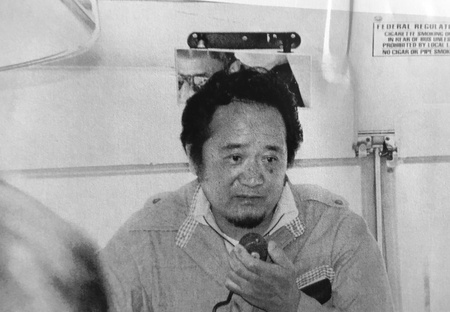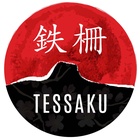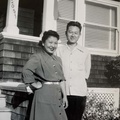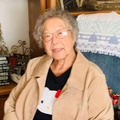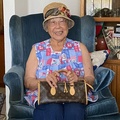Bob, can I go back? Do you remember your experience going from Watsonville to the assembly center? And then from the assembly center to Tule Lake?
Oh when we first moved we went to Davis. I would spend my junior year over in Davis. And that’s when Executive 9066 came. And so [a friend] Mr. Kearney had a dairy farm there. He says look we got to get you down to the train, so I’ll drive you down in the truck with your luggage. A very nice person, I really liked him.
So when we got to the train station south of Sacramento, there were soldiers with their rifles and guards and everything like that. We got them all lined up. We had to register, that’s where we got our family number which was 37315. And it was about late afternoon, the train got started and they told us we were going to Tule Lake. So here we think, “Wow, we’re going to Tule Lake! We can go swimming every night.” We thought we were going to see a lot of green trees and lake and so on. But it was just a dry lake bed.
So no assembly center? You went directly from Sacramento to Tule Lake?
Yes, yes no assembly center in-between. Which I understand was a good thing because the assembly centers were all temporary.
Were the shades drawn or were you able to see?
We had to have the shades drawn we weren’t supposed to look but we always peeked. But we had to keep them all the way down.
Did they tell you why?
Well, I guess they didn’t want us to know where we were going. Or I guess they didn’t want other people to see us inside, that we were a special train. But anyway, you know I can’t remember. We must’ve had something to eat?
I was going to say, did they feed you?
I can’t remember being served anything, they must’ve come down the aisle with, onigiri? I don’t know. I don’t think they thought that far. So once we got our assignments to the barracks, you get used to waiting in line, we got in line at the mess hall. The cooks were already there from the very first group. Because when I went, they were still building barracks. They had an assembly line, cutting lumber to size.
Who were putting them together? Was it the Japanese Americans that were putting it together?
No, they were hakujins. They probably got a fabulous salary, whereas we were getting 16 bucks a month. So being a truck driver, I’d go over there and I used to go there and pick up some lumber and I would put them in the back of the truck and take it to my place. I made furniture for the family, chairs, little stands, partitions in-between. I used to go there we had nothing, just a pot belly stove and maybe one light in the ceiling. Nothing else.
Where’d you get the hammer and nails?
My father was very–I was think about that. I think he was really a genius. In his suitcase, he threw in a hammer, a can of nails and a small saw. And he packed that, we weren’t supposed to bring any of that stuff. But he had that in there and my father said, “Gee they got me some lumber. We can start making furniture.” So I would make little chairs and little tables, maybe some shelving for books. So that really worked out great.
Fortunately I think I kept going in the right direction. Even in the army. If it wasn’t for my father [who didn’t want him going into the army], I don’t know if I’d be here or not. Because I was being train as a replacement for the 442. And some of my classmates, who didn’t have this interruption, never made it back.
And my wife’s brother, Stanley, he was in the army even before Pearl Harbor and he was in the Air Force but he ended up in Europe with the 522nd which was the artillery branch of the 442, and he was on the patrol with about four of his buddies. And they got pinned down by a German group and they were in a ditch. And it was a matter of time before the rest of the German soldiers got reinforcements. And that was it, they don’t take prisoners.
So Stanley had what you called a Carbine which isn’t a powerful instrument. He decided they can’t stay there, and the Germans had one machine gun, that’s what was keeping them pinned down, it fired about 1200 rounds per minute. He just went across the plains and kept firing and he managed to get a couple of the German soldiers. And then when the machine gunner was knocked out, the other German soldiers took off. But the last guy who was retreating threw a hand grenade at Stanley and [Robert’s voice shakes] that was it.
But you know, he was buried over there but after the war they brought him back and they buried him at the Golden Gate cemetery. And Stanley’s sister was there too and she received a flag from the army personnel. They also gave her the Silver Star. Which is a piece of metal but this was several years after. I guess we get a little blasé, is that the word, after all this time. Like I said, I was given this Congressional Gold Medal which is great, and it’s fine but it doesn’t have much meaning anymore. You forget what you went through. Can I move on to Japan?
Yes, please.
After I got my basic training, I was supposed to be assigned to the 442nd over in Europe. But VJ Day came around first, so they had no use for me, unlike my two older brothers.. They had to go into these caves and flush people out and talk to the people because they spoke Japanese. Very fluently. And they even got into combat. My brother told me this last year, we talked on the phone, he lived in Chicago. He was telling me when he was in the Philippines on Mindanao, he heard voices out of one of the camp, and he said, it sounded like my brother, Shiz! So he pulled the flap and stuck his head in, and my brother was there! Of all the times, they’re in the middle of the war.
So they were actually in the Pacific, in the fight? Wow.
Oh sure they did. The Military Intelligence (MIS) they didn’t have a regiment or such, they assigned these graduates of the military intelligence in Japanese schools, they assigned people to different battalions. So they might be maybe six interpretive translators. And they need them for translations, to talk to the enemy. Or they’d get a lot of Japanese military documents they’d have to interpret.
You can imagine, it’d be hard for them to pull the trigger when the other side is Japanese.
A lot of times they had to go into these caves because the civilians are in there. And they’d say the U.S. army are not going to hurt you, come on out. They’d have to talk to them. But the Japanese soldiers that were in these caves, they wouldn’t come out, so they’d get the flame throwers in there. What else could they do? They did get a few prisoners. But they were taught that the U.S. army people are very cruel and that they’re really going to torture and everything, so you have to commit suicide. And how’d they do it? They get their hand grenade and hold it to their stomach. They couldn’t get them out. But they did get a lot of the civilians out. The mothers come out, the children behind them. They’re expecting to get executed and they come out and one of the GIs used to do is give them chocolate bars, bread, whatever they had. But those words don’t get around when you’re fighting.
Where were you stationed?
I was stationed right in Tokyo. The surrender was on August 15th, one day before my birthday. My number two brother was in the landing craft. And they need interpreters to talk to the public, to talk to whoever. He said the gates went down and they all started marching up and he says, he was never so scared, he didn’t know if it was soldiers to approach you, didn’t know what to expect. But there were a bunch of people out there on the dunes and it was the public, and they were welcomed. There was no fighting. He said that was such a big relief to them, they didn’t know what to expect.
The first night, we stayed in Tokyo. We slept at the finance building, which is right across from the palace, one of the few buildings left standing. They were given orders to not bomb the palace grounds. You want to bomb all around the thing, okay go ahead but not the palace grounds.
One of the first nights after our first meal, let’s all go out and see what Tokyo’s like. And I look at the public walking around and I’m thinking, my gosh they all look like me! I lived in a small town and there wasn’t a big Japanese community. And I’m just astounded looking around, and they all look like me.
So the next day we went to our building. It was the Kempeitai building, it’s the secret police. It’s a group of army people that people were afraid of because they had power, And they thought you did something. This type of a police organization. We took over that building.
What happened when you came back from Japan and you resettled back home?
Well my parents were in the Richmond housing project because they had no place to come back to. They had this extra bedroom in there. And so I stayed there for a while. It wasn’t much of a place but that’s all they could do at the time. My father came out of camp, worked as a gardener, and started his own business. But they coped with whatever problems there were, but they were happy. I’ll put it that way, they were happy.
Which camp did your father pass away in?
In Topaz. You know something? I’m just kind of wondering where he is now. What did my brothers do with his ashes? I’m going to have to look into that.
*Thank you to the Japanese American Museum of San Jose for coordinating this interview
*This article was originally published on Tessaku on March 8, 2017.
© 2017 Emiko Tsuchida



